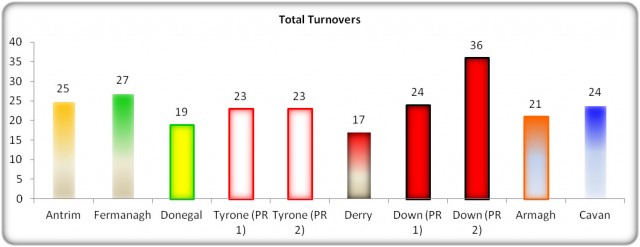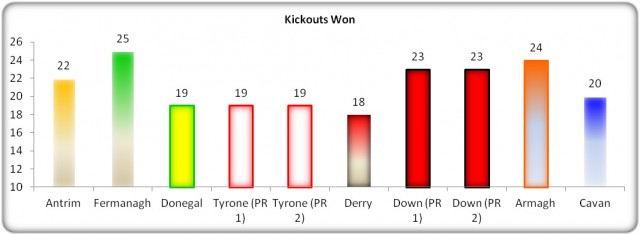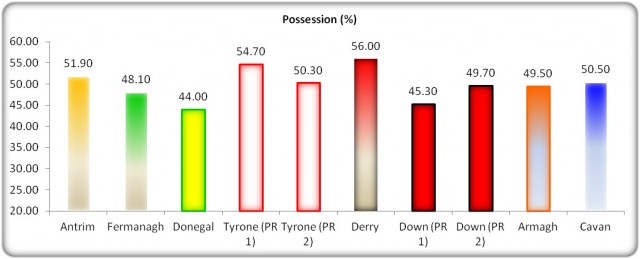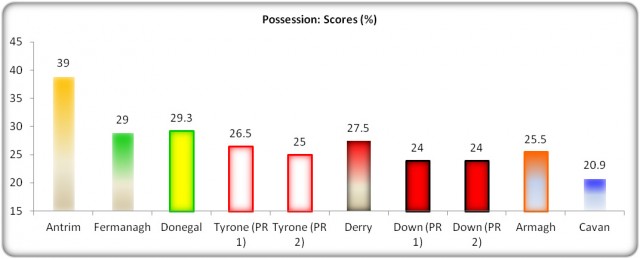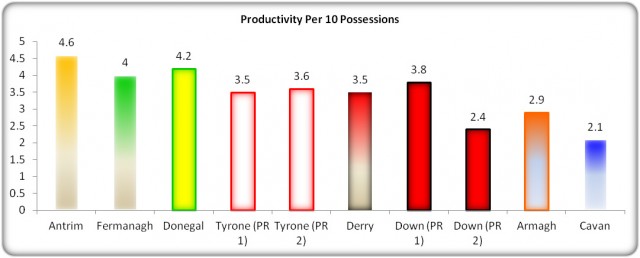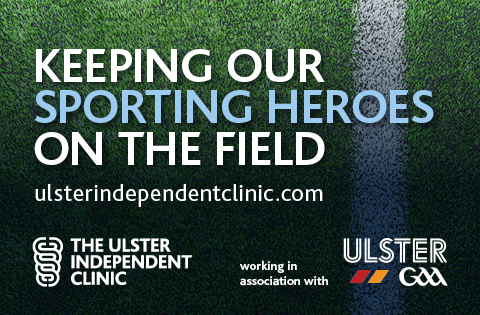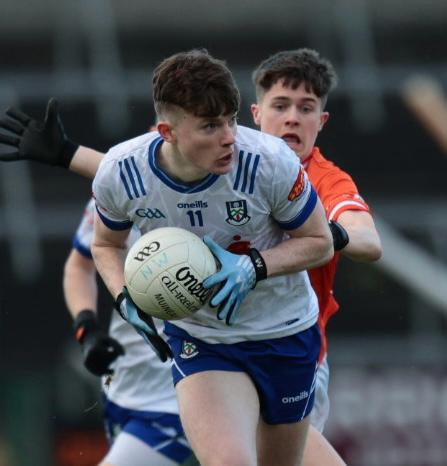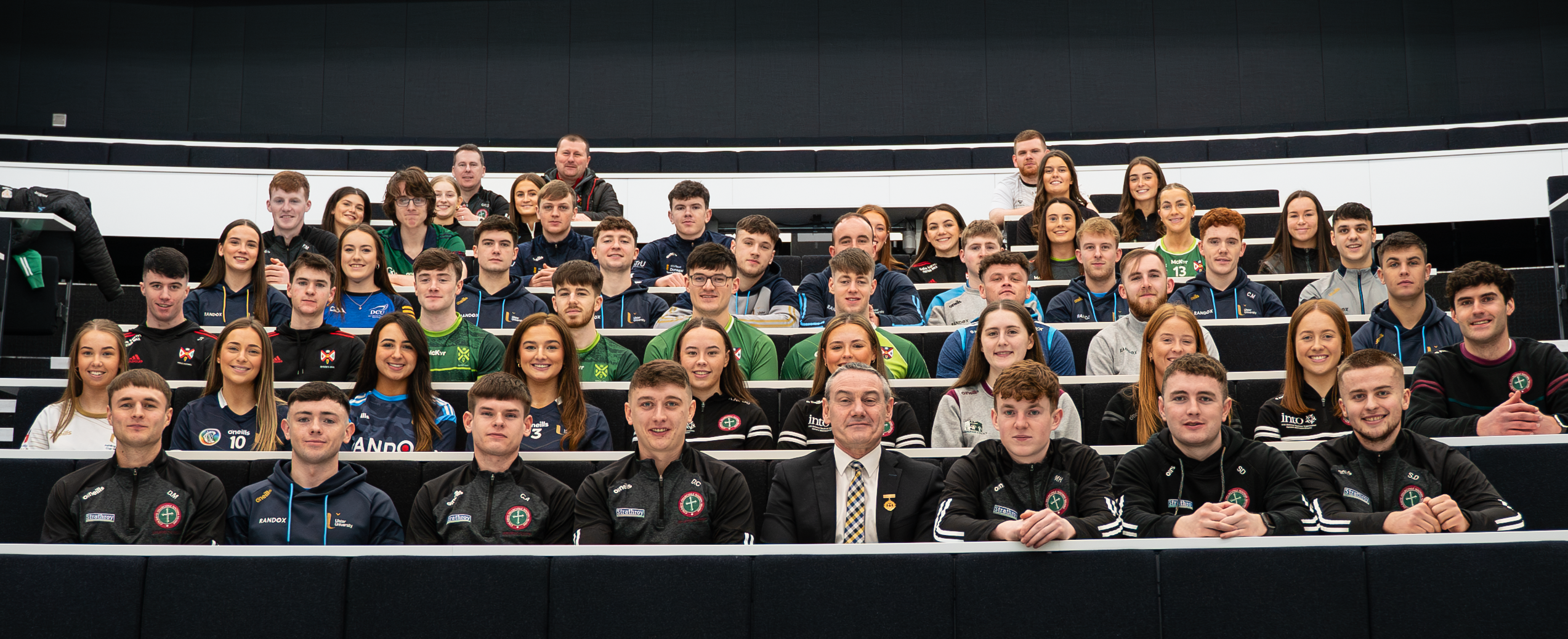Statistical Analysis of Armagh v Cavan
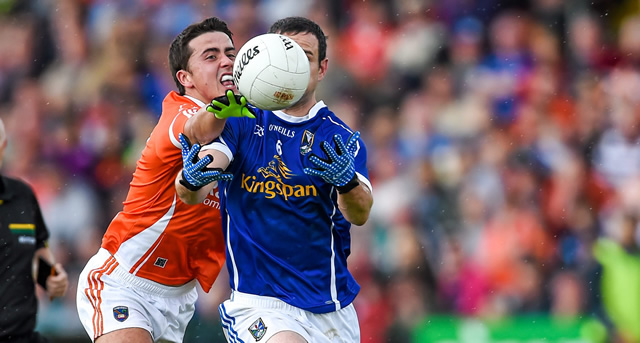
Throughout the 2014 Ulster Senior Championship, Ulster GAA will be compiling a report of the key statistics from each match. The reports will look at a range of factors contributing to game play, including possession breakdown, kick out success, possession to scores ratios and turnover stats.
The purpose of this project is to identify the key differences between team performance, and possibly help pin point where the key differences existed. Ultimately, it is hoped to identify the key area each team needs to address ahead of their next championship outing in 2014.
Ball in Play
Following last week’s highest scoring game of the Ulster Championship this week provided the lowest number of scores so far, with just 22 scores. With fewer scores comes fewer stoppages in play and therefore a greater playing time.
During this game, the ball was in play for 49% of the time, the highest proportion of playing time yet in this year’s Ulster Championship. At this stage there is a definite pattern developing, with higher scoring games providing less active time, by comparison to lower scoring games. This is interesting largely on the basis that we generally find higher score games more entertaining, whereas in the past there were calls for more active game time to help the entertainment level of matches.
Figure 1A & 1B: Active Game Time
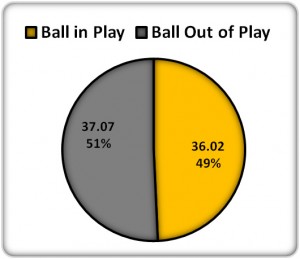
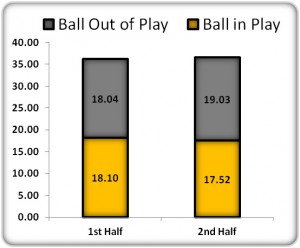
Possession
The possession battle in this match was very evenly balanced, with Cavan enjoying marginally more in the first half (2A), while Armagh swayed the battle slightly in the second half (2B). On the whole, Armagh emerged with slightly more possession, albeit this advantage was only 1% (Figure 3). Given that possession was so evenly balanced we can look to both teams’ use of possession to establish the reasons for the 6 point winning margin that Armagh enjoyed.
Figure 2A & 2B: 1st & 2nd Half Possession
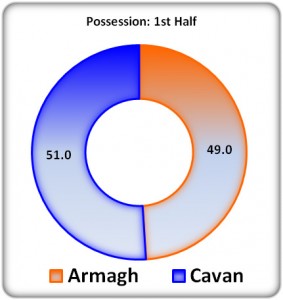
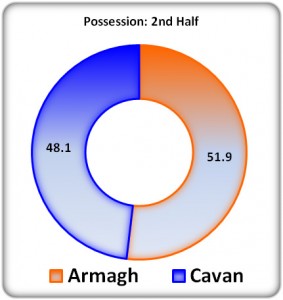
Figure 3: Full Match Possession
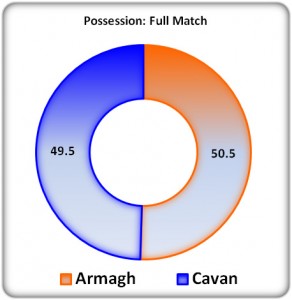
Kick Out Statistics
Initial commentary of this game suggested that Armagh dominated the midfield battle. When we look at the kick out statistics (Figure 4) it is clear that Armagh certainly enjoyed superiority in this sector, but it would be harsh on Cavan to suggest that Armagh ‘dominated’ this area. As with any team, Cavan will want to address this balance ahead of their Qualifier clash with Westmeath, and would like to be aiming to secure at least a 50% share of all kick out ball. By the same token, Armagh will be keen to consolidate this midfield advantage when they face either Monaghan or Tyrone in the Ulster Semi Final.
Figure 4: Kick Outs Won
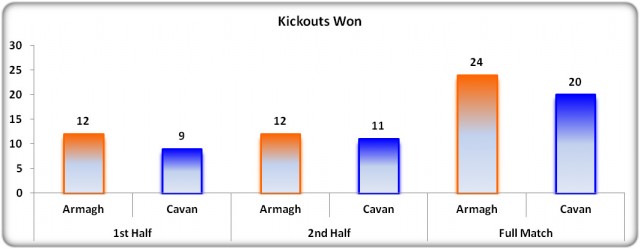
Upon analysis of the kick outs (Figure 5), Cavan have clear evidence that their short kick out routine paid dividends, gaining possession 7 times from their own kicks via a short kick. Their main area for concern is clearly when the kick out is taken long and possession is to be competed for, having lost 7 of their own kick outs cleanly to Armagh. They only won 2 of their own kicks clean and 5 via break ball.
Armagh will have been happy to have claimed such a high number of kick outs direct from Cavan kicks. On top of the 7 they claimed cleanly, they also secured 4 via break ball, with one going out directly for a sideline ball. This is a total of 12 possessions secured from Cavan kick outs. Cavan only won 14 of their own kick outs. Armagh’s own kick outs provided a fairly mixed bag in terms of outcome, but Armagh will be content to have secured possession from 12 of their 18 kick outs. While not a major issue, they will be keen to assess how Cavan managed to win 3 of the Armagh kick outs cleanly.
Figure 5: Kick Out Breakdown
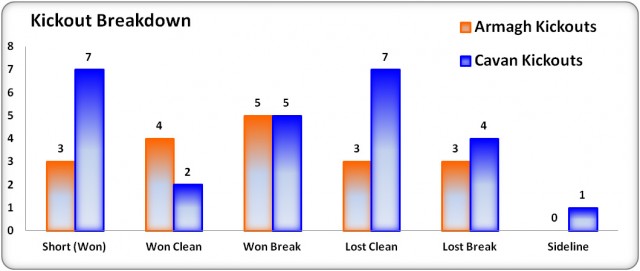
Turnovers
Both teams displayed a reasonably high degree of competence in terms of ball retention (Figure 6). Armagh only lost possession on 21 occasions, only Donegal and Derry have returned lower figures to date. Cavan were only marginally worse, coughing up possession 24 times. Both teams will pay attention to the volume of possession lost following short or blocked efforts for scores, having both turned over 6 times through this method. While not an overly disappointing figure, Cavan may also point to 8 possessions they lost through kick passing as an area for improvement, while Armagh may focus on having lost 5 possessions in the tackle.
Figure 6: Turnovers
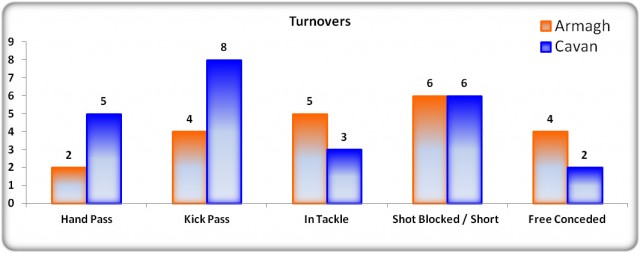
Possession to Scores Ratios
Up to now we have witnessed marginal superiority in possession stakes for Armagh, however, this marginal superiority translated to a 6 point winning margin suggesting that Armagh’s use of possession was much more effective than Cavan’s (Figure 7).
Both teams were able to progress possession into attacking positions with similar regularity, with Cavan slightly less effective at creating shots from their attacks. Neither team will have been overly happy with their shot return, with Armagh scoring from 37% of shots taken, while Cavan only managed to score from 33% of shots taken. On this basis it is fair to argue that both teams displayed issues with their finishing abilities which they will be keen to address ahead of their next outings.
Both teams will have similar concerns, with a significant number of shots resulting in wide balls (Armagh = 13, Cavan = 9). Both teams also had 4 shots fall short, and 4 blocked or saved over the course of the game. Further video analysis of the match will help coaches and players to understand if the issues lay in decision making or execution of the shots.
Figure 7A & 7B: Possession to Scores Ratios & Shot Outcomes
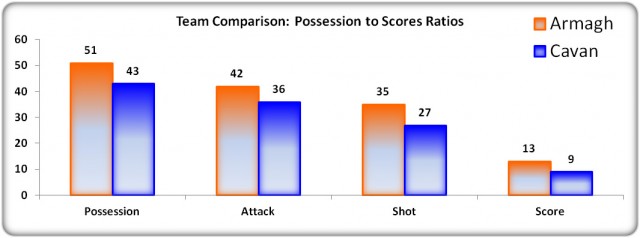
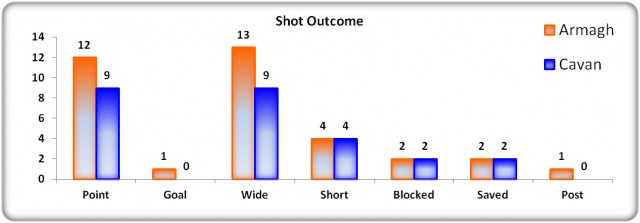
The finishing issues evident above impacted on the productivity of both teams. Armagh delivered a rating of 2.9 points per 10 possessions, the only lower value prior to this game was Down in their replay against Tyrone, registering 2.4. However, luckily for Armagh, Cavan registered the lowest productivity rating to date in this year’s championship, with a return of 2.09 points per 10 possessions. Neither team will be happy with their return, especially when compared to the top rating of this year’s championship which came courtesy of Antrim last week, with a value of 4.6 points per 10 possessions.
Figure 8: Productivity
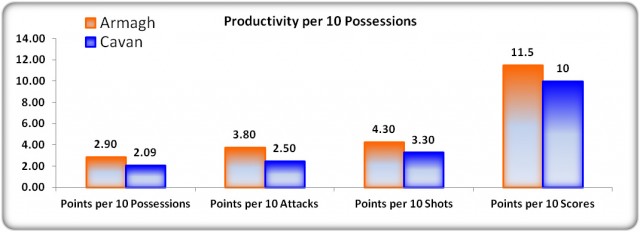
Summary
Based upon the statistics, the final outcome of this match appeared to be a result of the accumulation of a succession of marginal victories for Armagh in various aspects of the game. Armagh were slightly superior in terms of possession share, kick out superiority, turnover count and ultimately productivity. All these small victories combined to deliver what was a fairly comfortable 6 point victory for Armagh.
From the point of view of quality, there was a reasonably high level of skill demonstrated, with 36% of all kick outs claimed via clean catches. There were also only 12 kick passing and 7 hand passing turnovers, which would suggest a good standard of passing throughout the match, both in terms of decision making and execution. Where the quality appears to have dropped was in the finishing of both teams, with Armagh only converting 37% of their shots to score, and Cavan even less, with only 33% of shots converted.
Armagh
The key improvement Armagh will look to make ahead of the semi final will be in their shot success rate, and ultimately their productivity. Despite their superior possession and ability to create shooting chances this was not reflected in their scoring, having returned scores from just 13 of their 35 attempts. A significant number of wides combined with several short, blocked and saved shots limited their impact on the score board. Despite their superiority in all other aspects this may have counted for little had Cavan been more productive themselves. As it was, Cavan were less productive than Armagh in this match.
Cavan
Cavan’s initial concerns will almost certainly surround the ability to secure possession from their own kick outs. They sacrificed possession cleanly on 7 occasions from their own kick outs. Their short kick outs were successful, allowing them to gain possession 7 times, but they will be keen to address the kick that they are forced to play long, in particular the volume of kicks they lose cleanly to the opposition.
The other key improvement Cavan will be keen to make will be on their shooting return. Similarly to Armagh, Cavan only converted 33% of their scoring attempts, with the same issues evident. That is, a total of 8 shots were either short, blocked or saved, as well as 9 shots wide over the course of the game. A more clinical return in this game could have contributed to a much tighter score line, and possibly even a win given Armagh’s poor return in front of goal also.
USFC 2014 – Summarised
Below is a selection of key aspects of game play from the 2014 USFC. It allows for comparison between the teams that have played to date across this range of key aspects.
